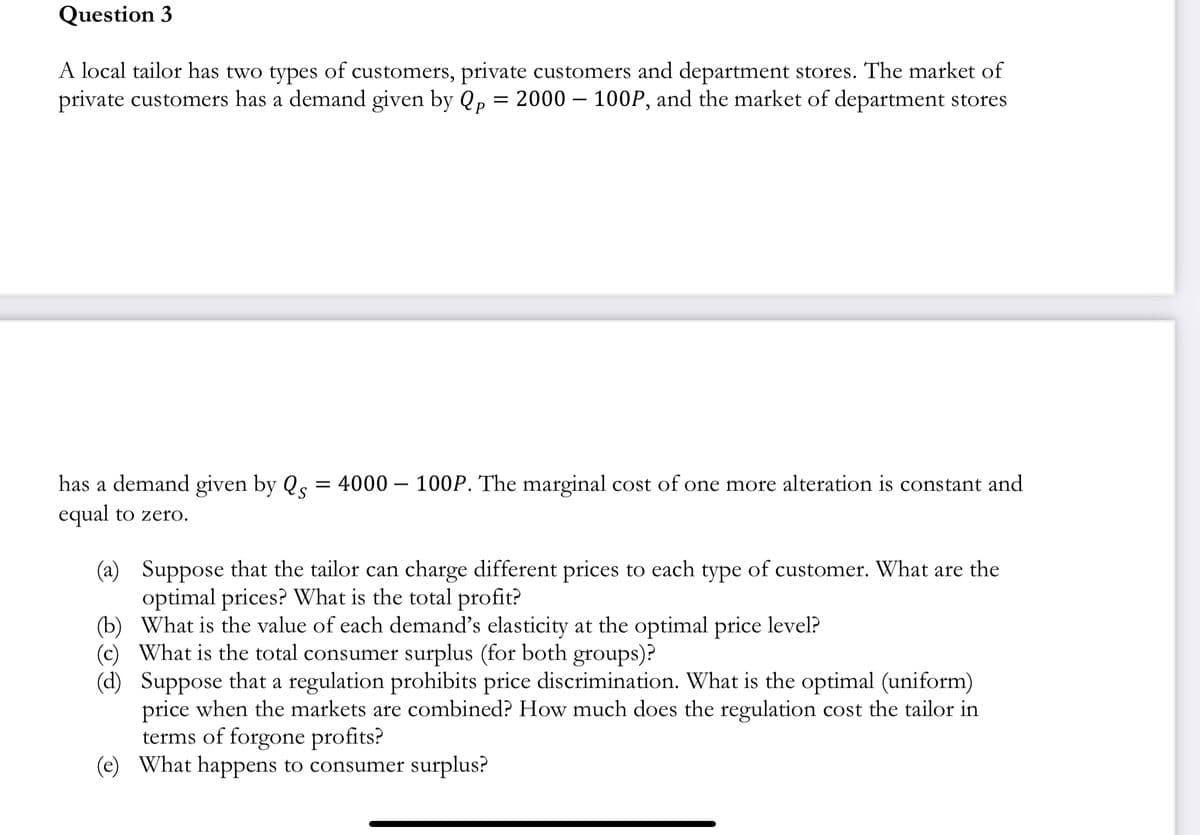a demand given by Qs = 4000 - 100P. The marginal cost of one more alteration is constant and al to zero. (a) (b) What is the value of each demand's elasticity at the optimal price level? (c) What is the total consumer surplus (for both groups)? (d) Suppose that a regulation prohibits price discrimination. What is the optimal (uniform) price when the markets are combined? How much does the regulation cost the tailor in terms of forgone profits? (e) What happens to consumer surplus? Suppose that the tailor can charge different prices to each type of customer. What are the optimal prices? What is the total profit?
a demand given by Qs = 4000 - 100P. The marginal cost of one more alteration is constant and al to zero. (a) (b) What is the value of each demand's elasticity at the optimal price level? (c) What is the total consumer surplus (for both groups)? (d) Suppose that a regulation prohibits price discrimination. What is the optimal (uniform) price when the markets are combined? How much does the regulation cost the tailor in terms of forgone profits? (e) What happens to consumer surplus? Suppose that the tailor can charge different prices to each type of customer. What are the optimal prices? What is the total profit?
Managerial Economics: Applications, Strategies and Tactics (MindTap Course List)
14th Edition
ISBN:9781305506381
Author:James R. McGuigan, R. Charles Moyer, Frederick H.deB. Harris
Publisher:James R. McGuigan, R. Charles Moyer, Frederick H.deB. Harris
Chapter3: Demand Analysis
Section: Chapter Questions
Problem 9E
Related questions
Question

Transcribed Image Text:Question 3
A local tailor has two types of customers, private customers and department stores. The market of
private customers has a demand given by Qp = 2000 – 100P, and the market of department stores
=
has a demand given by Qs
equal to zero.
4000 100P. The marginal cost of one more alteration is constant and
(a)
(b) What is the value of each demand's elasticity at the optimal price level?
(c) What is the total consumer surplus (for both groups)?
(d)
Suppose that the tailor can charge different prices to each type of customer. What are the
optimal prices? What is the total profit?
Suppose that a regulation prohibits price discrimination. What is the optimal (uniform)
price when the markets are combined? How much does the regulation cost the tailor in
terms of forgone profits?
(e) What happens to consumer surplus?
Expert Solution
This question has been solved!
Explore an expertly crafted, step-by-step solution for a thorough understanding of key concepts.
This is a popular solution!
Trending now
This is a popular solution!
Step by step
Solved in 4 steps with 4 images

Knowledge Booster
Learn more about
Need a deep-dive on the concept behind this application? Look no further. Learn more about this topic, economics and related others by exploring similar questions and additional content below.Recommended textbooks for you

Managerial Economics: Applications, Strategies an…
Economics
ISBN:
9781305506381
Author:
James R. McGuigan, R. Charles Moyer, Frederick H.deB. Harris
Publisher:
Cengage Learning

Managerial Economics: A Problem Solving Approach
Economics
ISBN:
9781337106665
Author:
Luke M. Froeb, Brian T. McCann, Michael R. Ward, Mike Shor
Publisher:
Cengage Learning

Exploring Economics
Economics
ISBN:
9781544336329
Author:
Robert L. Sexton
Publisher:
SAGE Publications, Inc

Managerial Economics: Applications, Strategies an…
Economics
ISBN:
9781305506381
Author:
James R. McGuigan, R. Charles Moyer, Frederick H.deB. Harris
Publisher:
Cengage Learning

Managerial Economics: A Problem Solving Approach
Economics
ISBN:
9781337106665
Author:
Luke M. Froeb, Brian T. McCann, Michael R. Ward, Mike Shor
Publisher:
Cengage Learning

Exploring Economics
Economics
ISBN:
9781544336329
Author:
Robert L. Sexton
Publisher:
SAGE Publications, Inc


Principles of Economics 2e
Economics
ISBN:
9781947172364
Author:
Steven A. Greenlaw; David Shapiro
Publisher:
OpenStax